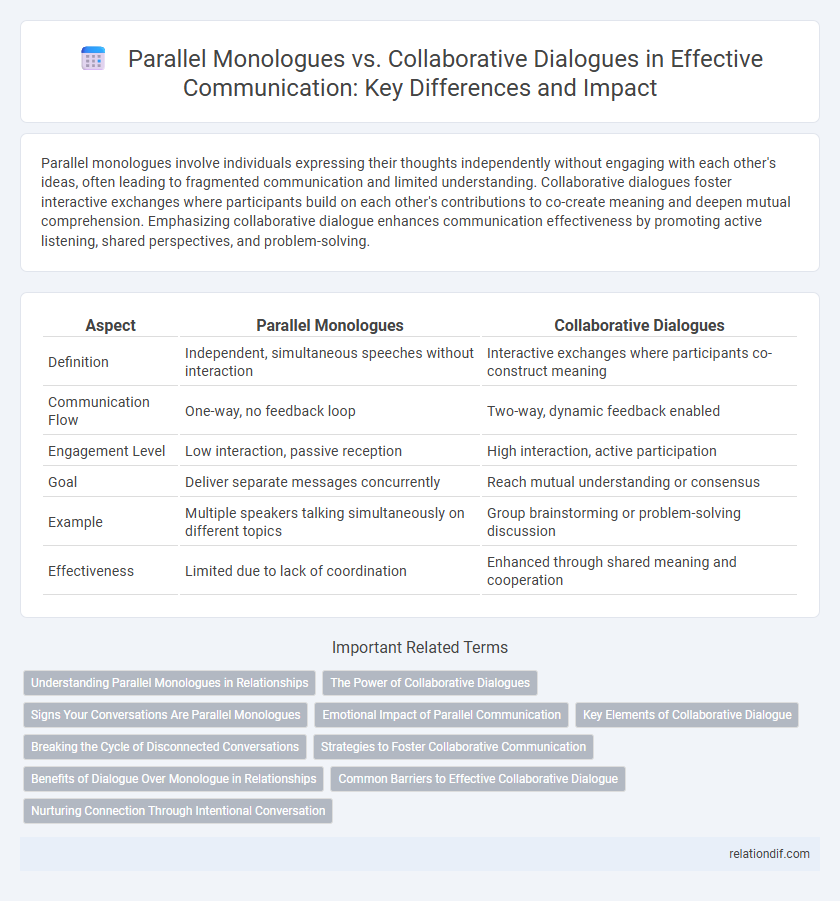Parallel monologues involve individuals expressing their thoughts independently without engaging with each other's ideas, often leading to fragmented communication and limited understanding. Collaborative dialogues foster interactive exchanges where participants build on each other's contributions to co-create meaning and deepen mutual comprehension. Emphasizing collaborative dialogue enhances communication effectiveness by promoting active listening, shared perspectives, and problem-solving.
Table of Comparison
| Aspect | Parallel Monologues | Collaborative Dialogues |
|---|---|---|
| Definition | Independent, simultaneous speeches without interaction | Interactive exchanges where participants co-construct meaning |
| Communication Flow | One-way, no feedback loop | Two-way, dynamic feedback enabled |
| Engagement Level | Low interaction, passive reception | High interaction, active participation |
| Goal | Deliver separate messages concurrently | Reach mutual understanding or consensus |
| Example | Multiple speakers talking simultaneously on different topics | Group brainstorming or problem-solving discussion |
| Effectiveness | Limited due to lack of coordination | Enhanced through shared meaning and cooperation |
Understanding Parallel Monologues in Relationships
Parallel monologues in relationships occur when individuals express their thoughts without actively engaging or responding to each other, leading to missed opportunities for deeper connection and mutual understanding. This communication pattern often results in feelings of isolation and misunderstanding, as each person remains focused on their own narrative rather than collaboratively building the conversation. Recognizing and shifting away from parallel monologues toward collaborative dialogues can significantly enhance empathy and strengthen emotional bonds.
The Power of Collaborative Dialogues
Collaborative dialogues harness the power of active listening, mutual understanding, and shared meaning-making, driving more effective problem-solving and innovation than parallel monologues. These exchanges promote dynamic feedback, allowing participants to build on each other's ideas, fostering deeper engagement and trust. Research highlights that collaborative dialogues enhance team performance by creating an environment where diverse perspectives converge into actionable insights.
Signs Your Conversations Are Parallel Monologues
Signs your conversations are parallel monologues include frequent interruptions, lack of active listening, and minimal reciprocal exchange of ideas. Participants often focus on their own points without acknowledging or building on others' contributions, creating disconnected communication threads. This pattern results in talking past each other rather than engaging in meaningful collaborative dialogue.
Emotional Impact of Parallel Communication
Parallel monologues often result in fragmented emotional experiences, where participants express feelings without mutual understanding, limiting empathy and emotional connection. In contrast, collaborative dialogues foster shared emotional resonance through active listening and responsive interactions. This collective engagement enhances emotional impact by creating a safe space for authentic expression and emotional validation.
Key Elements of Collaborative Dialogue
Collaborative dialogue emphasizes active listening, mutual understanding, and constructive feedback, contrasting with parallel monologues where participants speak without interaction. Key elements include turn-taking, shared goals, and responsive engagement, enabling deeper knowledge exchange and problem-solving. This dynamic fosters co-construction of meaning, enhancing communication effectiveness and relationship building.
Breaking the Cycle of Disconnected Conversations
Parallel monologues often result in disconnected conversations where participants talk past each other without genuine engagement. Collaborative dialogues prioritize active listening and shared understanding, fostering connection and meaningful exchange. Breaking the cycle of disconnected conversations requires shifting from individual expressions to interactive communication patterns that emphasize empathy and responsiveness.
Strategies to Foster Collaborative Communication
Encouraging active listening and open-ended questioning enhances collaborative communication by transforming parallel monologues into interactive dialogues. Implementing structured turn-taking methods ensures each participant's perspective is acknowledged, fostering mutual understanding and collective problem-solving. Utilizing feedback loops and shared goals aligns contributions, promoting a cohesive exchange rather than isolated monologues.
Benefits of Dialogue Over Monologue in Relationships
Collaborative dialogues foster mutual understanding through active listening and shared perspectives, strengthening emotional bonds in relationships. Engaging in dialogue encourages empathy and conflict resolution by allowing each person to express and respond to feelings openly. Unlike parallel monologues, dialogues build trust and intimacy by creating a dynamic exchange rather than isolated, unilateral communication.
Common Barriers to Effective Collaborative Dialogue
Common barriers to effective collaborative dialogue include entrenched assumptions, lack of active listening, and power imbalances that hinder open exchange. Parallel monologues often reinforce these obstacles by isolating perspectives rather than fostering mutual understanding. Overcoming these challenges requires intentional efforts to create psychological safety, encourage empathy, and establish shared goals that prioritize collective meaning-making.
Nurturing Connection Through Intentional Conversation
Parallel monologues occur when participants speak without truly engaging, limiting opportunities for genuine connection and understanding. Collaborative dialogues prioritize active listening and reciprocal exchange, fostering deeper relationships through shared meaning and empathy. Intentional conversation harnesses collaborative dialogue techniques to nurture trust, empathy, and mutual respect in communication.
parallel monologues vs collaborative dialogues Infographic

 relationdif.com
relationdif.com